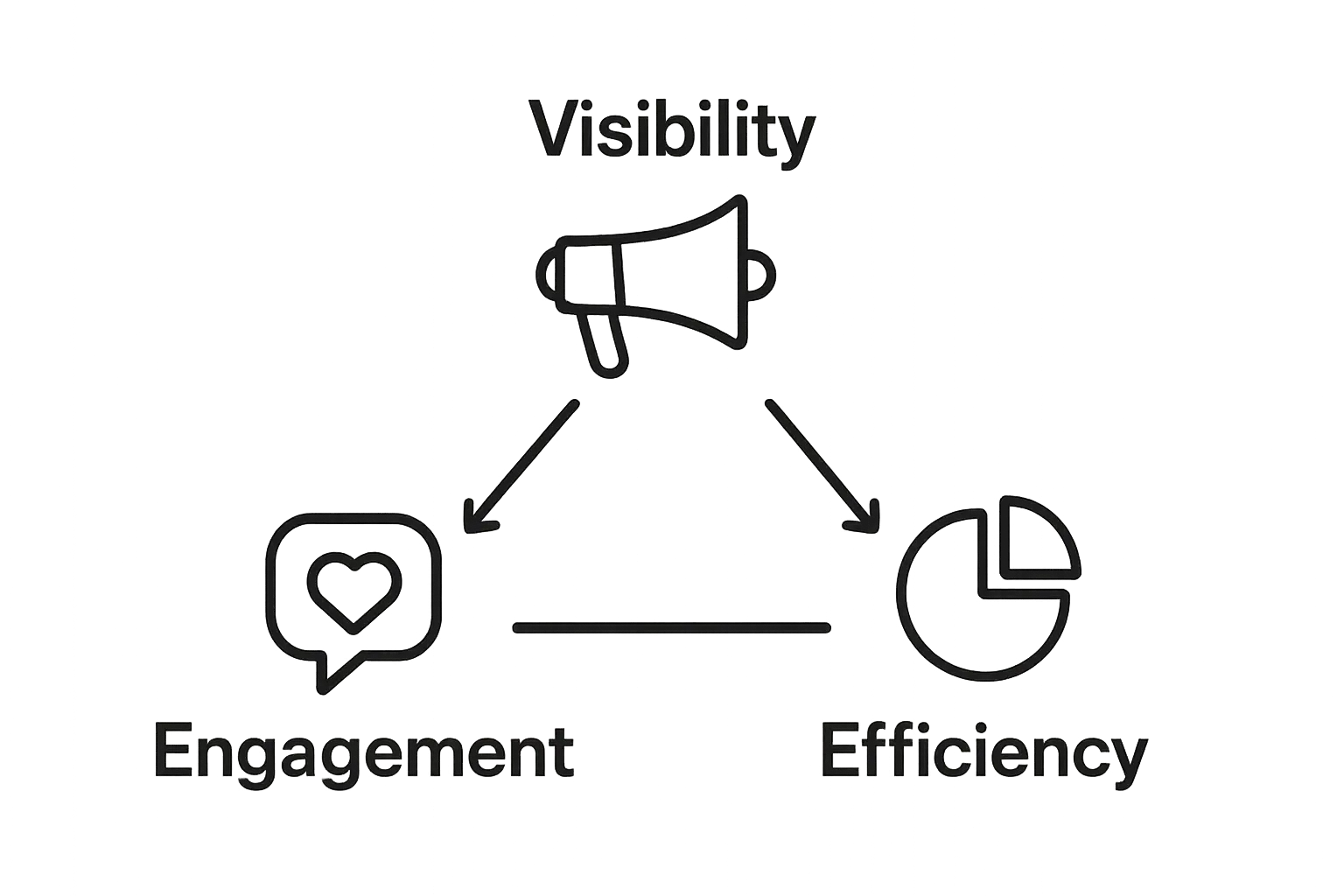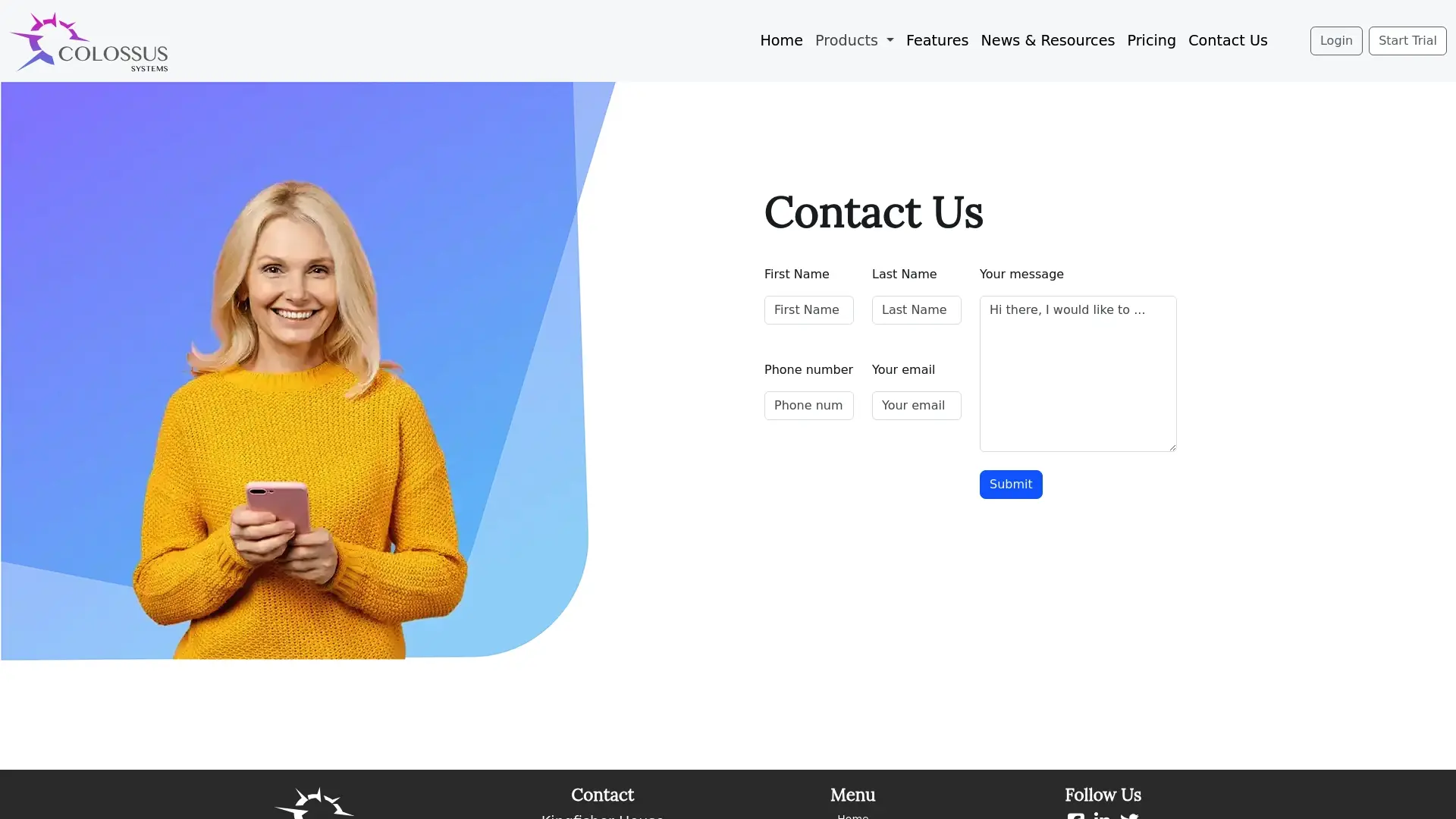Understanding Digital Communications Strategy in Depth

Every organisation wants to connect with its audience online. Yet only a tiny fraction have a proper plan for how they communicate. In fact, organisations with a strong digital communications strategy see much higher brand recognition and engagement compared to their competitors. You might expect the focus to be on flashy technology or posting more updates. The real power sits in quietly aligning every message with audience needs and building trust that lasts.
Table of Contents
- What Is A Digital Communications Strategy?
- The Importance Of Digital Communications Strategy
- Key Components Of Digital Communications Strategy
- How Digital Communications Strategy Works In Practice
- Challenges And Trends In Digital Communications Strategy
Quick Summary
| Takeaway | Explanation |
|---|---|
| Understand your audience deeply | Create detailed personas to tailor digital communication effectively. This enhances relatability and engagement with your target groups. |
| Align goals with communication strategies | Ensure your digital communication objectives reflect and support overall organisational goals for coherent messaging. |
| Leverage data analytics for insights | Use sophisticated data tools to track audience behaviour and engagement. This informs strategy adjustments and improves resource allocation. |
| Adopt agile communication techniques | Develop adaptable frameworks that can swiftly respond to trends and audience feedback, enhancing responsiveness and relevance. |
| Create interactive engagement experiences | Move beyond one-way broadcasting to foster dynamic dialogues that resonate with your audience’s needs and preferences. |
What is a Digital Communications Strategy?
A digital communications strategy represents a comprehensive plan that organisations use to communicate effectively through digital channels, connecting with audiences in meaningful and strategic ways. Unlike traditional communication approaches, this strategy integrates multiple digital platforms and technologies to create cohesive, targeted messaging that resonates with specific audience segments.
The following table provides a concise overview of the core components of a digital communications strategy and their primary functions as discussed in the article.
| Core Component | Description |
|---|---|
| Audience Understanding | Development of detailed personas and mapping of communication pathways |
| Channel Selection | Identification of the most suitable digital platforms for each message |
| Content Planning | Creation of engaging, relevant content to address audience needs |
| Strategic Planning | Framework aligning communication objectives with wider organisational aims |
| Content & Channel Management | Coordination of tailored content and platform use for effectiveness |
| Performance Monitoring | Use of analytics to assess and adapt strategy according to engagement |
Core Components of Digital Communications
At its fundamental level, a digital communications strategy encompasses several critical elements that work together to create powerful engagement:
- Audience Understanding: Developing detailed personas and mapping communication pathways
- Channel Selection: Identifying the most appropriate digital platforms for specific messaging
- Content Planning: Creating relevant, engaging content that speaks directly to audience needs
Organisations today recognise that digital communication is not merely about broadcasting messages but creating interactive, responsive experiences. Our comprehensive guide on digital engagement provides deeper insights into these sophisticated communication techniques.
Strategic Implementation Principles
Successful digital communication strategies require meticulous planning and execution. According to McKinsey & Company’s digital transformation research, effective strategies must:
-
Align digital communication objectives with broader organisational goals
-
Utilise data analytics to understand audience behaviour
-
Develop adaptive communication frameworks that can respond quickly to changing digital landscapes
The primary goal of a digital communications strategy is to create meaningful connections, transform audience interactions, and drive organisational objectives through purposeful, targeted digital engagement.
The Importance of Digital Communications Strategy
In an increasingly interconnected digital landscape, a robust digital communications strategy has transformed from a competitive advantage to an essential organisational requirement. Modern organisations must navigate complex communication ecosystems where traditional boundaries between internal and external messaging have become increasingly blurred.
Strategic Competitive Advantage
Digital communications strategies provide organisations with critical capabilities to differentiate themselves in crowded marketplaces. Our comprehensive guide on digital marketing for associations explores how strategic communication can create meaningful audience connections.
According to research from Harvard Business Review, organisations with sophisticated digital communication approaches experience significant benefits:
- Enhanced brand visibility and recognition
- Improved audience engagement and retention
- More efficient resource allocation across communication channels
- Greater adaptability to changing market dynamics

Audience Connection and Trust Building
Effective digital communication strategies transcend mere information dissemination. They represent nuanced approaches to building genuine relationships with stakeholders. By understanding audience preferences, communication patterns, and digital interaction behaviours, organisations can craft personalised, resonant messaging that builds long term trust and credibility.
The fundamental purpose of a digital communications strategy goes beyond broadcasting messages. It involves creating an interactive ecosystem where audiences feel heard, understood, and valued. This approach transforms communication from a one way transmission into a dynamic, responsive dialogue that adapts and evolves with audience needs and expectations.
Key Components of Digital Communications Strategy
A comprehensive digital communications strategy is built upon several interconnected components that work together to create a robust and responsive communication framework. Understanding these core elements is crucial for organisations seeking to develop effective digital engagement approaches.
Strategic Planning and Goal Alignment
Strategic planning forms the foundation of any successful digital communications approach. This involves creating a structured framework that aligns digital communication objectives with broader organisational goals. Our detailed guide on digital communication strategies for member organisations provides deeper insights into this critical process.
According to research from Harvard Business Review, effective strategic planning requires organisations to consider:
- Clear definition of communication objectives
- Identification of target audience segments
- Mapping of communication pathways and potential touchpoints
- Establishing measurable key performance indicators
Content and Channel Management
Successful digital communication strategies demand sophisticated content and channel management. This involves creating tailored content that resonates with specific audience segments and selecting appropriate digital platforms for message distribution.
Key considerations for content and channel management include:
- Understanding audience preferences and digital consumption habits
- Developing a consistent brand voice across different digital platforms
- Creating adaptable content that can be repurposed across multiple channels
- Implementing robust content governance and approval processes
The ultimate goal of these components is to create a dynamic, responsive communication ecosystem that enables organisations to connect meaningfully with their audiences, build trust, and drive strategic objectives through purposeful digital engagement.
How Digital Communications Strategy Works in Practice
A digital communications strategy transitions from theoretical framework to practical implementation through a systematic, iterative approach that emphasises continuous learning and adaptive communication techniques. This practical application requires organisations to develop sophisticated mechanisms for monitoring, engaging, and responding across multiple digital platforms.
Real-World Execution and Coordination
Implementing a digital communications strategy involves coordinated efforts across multiple organisational departments. Our guide on digital communication strategies for member organisations highlights the importance of cross-functional collaboration.
According to research from MIT Sloan Management Review, practical digital communication strategies typically involve:
- Establishing clear communication protocols
- Creating integrated technology ecosystems
- Developing responsive feedback mechanisms
- Implementing agile decision making processes
Data-Driven Performance Monitoring
Successful practical implementation relies heavily on sophisticated data analytics. Modern digital communication strategies leverage advanced tracking tools to measure engagement, sentiment, and audience interaction in real time. This enables organisations to:
- Understand audience behaviour patterns
- Identify emerging communication trends
- Quickly adapt messaging strategies
- Allocate resources more effectively
The practical application of a digital communications strategy transforms abstract objectives into measurable, actionable outcomes. By combining technological capabilities with strategic insights, organisations can create dynamic communication approaches that respond rapidly to changing audience needs and organisational goals.

Challenges and Trends in Digital Communications Strategy
Digital communications strategies continually evolve in response to technological advancements, shifting audience expectations, and emerging communication paradigms. Organisations must navigate complex challenges while simultaneously embracing innovative trends that redefine digital engagement approaches.
This table summarises the main technological challenges and adaptive trends shaping modern digital communications strategies, aiding readers in differentiating between ongoing obstacles and emerging opportunities.
| Challenge / Trend | Description |
|---|---|
| Rapid Technological Obsolescence | Keeping pace with evolving tech landscapes and timely platform updates |
| Data Privacy & Security Concerns | Ensuring compliance and building trust through responsible data handling |
| Platform Integration | Coordinating multiple communication tools for consistent messaging |
| Information Overload | Managing excessive digital content to maintain audience attention |
| Predictive Analytics | Leveraging data to anticipate and respond to audience needs |
| Conversational Marketing Platforms | Employing interactive tools to enhance two-way audience engagement |
| Immersive Digital Interactions | Creating richer experiences through personalisation and interactivity |
| Decentralised Communication | Empowering various units or members to participate in communication |
Emerging Technological Challenges
Technological complexity presents significant obstacles for organisations developing digital communication strategies. Our guide on digital marketing for associations explores these intricate technological dynamics.
According to Gartner’s Digital Transformation Research, contemporary digital communication challenges include:
- Rapid technological obsolescence
- Data privacy and security concerns
- Integration of multiple communication platforms
- Managing information overload
Adaptive Communication Trends
Modern digital communication strategies must remain flexible and responsive to emerging trends. Key developments transforming digital communication include artificial intelligence and personalisation technologies that enable more nuanced, targeted audience interactions.
Significant trends organisations must consider involve:
- Increasing use of predictive analytics
- Growth of conversational marketing platforms
- Enhanced customer experience through immersive digital interactions
- Decentralised communication ecosystems
Successful digital communication strategies will require continuous learning, technological adaptability, and a deep understanding of evolving audience engagement mechanisms. The future of digital communication demands organisations become agile, technologically sophisticated communicators capable of navigating complex digital landscapes.
Transform Your Digital Communications Into Lasting Member Engagement
Are you finding it challenging to unify your digital communications and consistently build trust with your members? If you are struggling to move from disconnected messaging to a single, effective strategy that strengthens relationships, you are not alone. The article explains how audience understanding, content planning, and data-driven engagement are essential for modern organisations but putting these ideas into practice is not always straightforward. Many membership organisations encounter confusion, lack of real-time data, and fragmented tools, which prevent them from truly reaching their audience.

Colossus Systems solves these pain points by integrating every aspect of your member communication within one simple platform. Imagine having member management, event planning, and targeted email marketing tools that work together seamlessly. Stop missing opportunities to engage your members at every touchpoint. Connect with us at Colossus Systems Contact to discover how an advanced digital communications strategy can help you scale your organisation quickly. Now is the right time to break down those silos and create lasting impact through purposeful digital engagement. Take your organisation to the next level with Colossus Systems today.
Frequently Asked Questions
What is a digital communications strategy?
A digital communications strategy is a comprehensive plan that organisations use to communicate effectively through digital channels, integrating multiple platforms to create cohesive and targeted messaging.
Why is a digital communications strategy important for organisations?
A digital communications strategy helps organisations differentiate themselves, enhance brand visibility, improve audience engagement, and adapt to changing market dynamics.
What are the key components of a digital communications strategy?
Key components include audience understanding, channel selection, content planning, strategic planning, and content and channel management.
How can organisations measure the effectiveness of their digital communications strategy?
Organisations can measure effectiveness through data analytics, tracking audience engagement, sentiment, and interaction patterns to adapt messaging and allocate resources effectively.
Recommended
- What is Digital Engagement? Understanding Its Impact|CS
- Digital Communication Strategies for Member Organisations|CS
- Understanding Digital Marketing for Associations | Colossus Systems
- Effective Community Engagement Tactics for Lasting Connections|CS
- What is Digital Marketing? Understanding Its Importance
- What Is Digital Marketing? Guide for US Business Owners 2025 - seo analytic